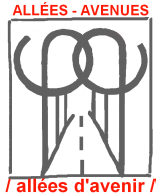Tree avenues
The French term ‘allée’ is used in many parts of Europe when referring to tree-lined ‘ways of passage’ in parks and gardens, in towns or in the country. In the context of landscapes, ‘avenue’ has the same meaning in English. ‘Avenues’ (or ‘tree avenues’) are thus ‘ways of passage’—paths, streets, roads, but also canals or tram lines—lined with rows of regularly spaced trees.
Avenues (in this sense) constitute a cultural heritage that has shaped and continues to shape our rural and urban landscapes in Europe and beyond for more than five centuries. Today, we also need tree avenues to combat biodiversity loss and climate change: they are valuable habitats and ecological corridors, they store carbon and protect us from heat. Above all, they bring us the beauty that is essential to life.
Tree avenues are protected in many countries (in France, they are protected by Article L350-3 of the Environment Code, adopted in 2016, amended in 2022 and supplemented in 2023), but their future remains very precarious: their management is too often inadequate, and planting or replanting is insufficient, as pointed out in the Carcassonne declaration.
Our actions
ALLÉES-AVENUES /allées d'avenir/ (avenues of the future) acts at a local and national level in France, and also at an international level. Our actions provide tools for all those involved in preserving this heritage, whether they are elected officials, tree, landscape or planning professionals, or ordinary citizens. They will also contribute to the future project of a European cultural route.
Actions of scientific nature:
Actions of technical nature:
- National meetings
- ‘Mémento’ (a guidebook in French about the protection of tree avenues)
- a Collaborative platform open to participants of the national meetings
Actions of artistic nature:
Advocacy actions:
- ‘Carcassonne Declaration’
- Support for external actors
- Publications
Lettre d'information Août 2025
Observatoire artistique de l'allée de frênes : Clap de fin pour les évènements 2025 à Trampot...
See the avenues through the eyes of artists
The next opportunity to see the 231 ash tree prints by artist Constance Fulda as part of our...
L'art pour attirer l'oeil sur la beauté singulière des allées d'arbres
Le vernissage de l'installation artistique réalisée par Constance Fulda à partir des 231...
A month dedicated to nature and art in the countryside
Following the photo exhibition by American artist Wayne Gudmundson, four new exceptional events...
Exposition Wayne Gudmundson et les allées - 26 avril au 25 mai
Venez rencontrer Wayne Gudmundson ce samedi 26 avril à Trampot. Après sa résidence artistique de...
La BD est sortie !
160 pages avec de très beaux dessins d'allées - Mathieu Flammarion les aime et a un vrai plaisir à...
Road safety: No, the trees are not the problem
"Should the plane trees along the roadsides be cut down?" The question has once again resurfaced...
Observatoire artistique de l'allée de frênes de Trampot - Saison 2024
La saison 2024 de l'Observatoire artistique de l'allée de frênes de Trampot s'est achevée. Elle a...
Avenue trees are not a road safety issue that needs to be addressed!
Viewing trees as a road safety issue to be solved is now a thing of the past. This is confirmed by...
Constance Fulda et Julie Ory : deux artistes qui nous rapprochent des arbres
" "Merci pour ce moment simple au bord des arbres. On en revient comme d'un long voyage.Ébahies et...
Christian Bobin, l'ami des allées d'arbres, a pris une autre route
Christian Bobin aimait les allées d'arbres. En 2007 il avait offert à notre déléguée un petit...
25 & 26 june 2022 : artistic performance in the ash tree avenue in Trampot
We are looking forward to seeing you on Saturday and Sunday, 25 and 26 June 2022, from 10 a.m. to...



